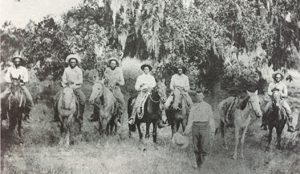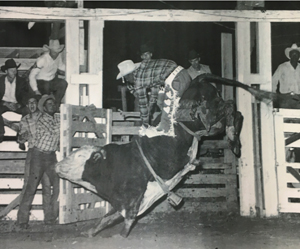A LITTLE PIECE OF HISTORY | By Joan Frances –

Group of Black Cowboys on Horses. Stock hands of Thomas W. Jones, 1880s. Jones is standing in the foreground. Third cowboy from left holds TJ brand of Thomas Jones (1840 – 95), son of George Ranch founder Henry Jones. Courtesy George Ranch Historical Park.
In the late 1800s, when cattle grazing and ranching encouraged economic and cultural growth, many pioneers traveled to Texas seeking cheap land, bringing their slaves with them. By 1825, 25 percent of the settler population were slaves.
Fort Bend County had several large, successful ranches. The Jones-Ryon Plantation, currently known as George Ranch, was a 25,000-acre working ranch that depended on slave labor and later hired help to keep it running smoothly for over 120 years.
When Texas joined the Confederacy in 1861, and the ranchers fought in the war, they depended on the slaves to maintain their land and cattle herds. These devoted workers developed the skills to herd, break horses, work the cattle drive and endure physical labor for 15 hours a day.
During the post-war era, the cattle industry became dependent on the knowledge of the African American slaves. In the years after the abolishment of slavery, the black cowboy became an invaluable asset to the cattle industry. Ranchers were compelled to hire these skilled cowhands, and historians estimate that one in four cowboys in Texas were African American.
Before the railroads were built, cattle needed to be moved to shipping points throughout the United States. Trails were treacherous, fraught with harsh environmental conditions, and Indians fought to defend their lands. The black cowboy had to deal with discrimination as they traveled through towns. They were barred from certain restaurants and hotels, but the camaraderie of these cowboys was undeniable. Within the group traveling together, there was a level of respect, rapport and equality unknown to other African Americans. Living and thriving on the open range, they never hesitated to share a blanket or a cup of coffee at the fireside with a fellow companion. Color was not an issue; the men worked, played and fought together.
The life on a working ranch was grueling. Countless hours of hard labor were necessary to keep it thriving successfully. These hired cowboys, who tended cattle and performed many duties on horseback, usually lived on the ranch and were paid minimally. The rate of pay was based on skill and length of time they worked on the property. The top hand on the Jones-Ryon Ranch was paid $20.00 a month. Some workers were paid by the day for 65 cents. While difficult, the life of a cowboy was better than the hardscrabble life of a sharecropper farmer, who had to contend with poor soil or unforgiving weather.

After the railroads were built, the African American Cowboy became a popular contender riding at rodeos in Fort Bend County.
During the postbellum years, the black cowboy provided the labor to expand the day-to-day operations on the Jones-Ryon Plantation. By 1896, the estate was worth $200,000, which included 8,000 head of cattle and 25,000 acres of land. By the turn of the century, the railroads were built, barbed wire was invented and the need for cattle drives decreased. This proved to be a rough transition for the cowboy. As an African American, land could not be easily purchased, and the new order of things did not appeal to a herdsman. Many pursued jobs working with the railroad or in the communities where they lived. The public took an interest in the cowboy lifestyle, making way for the popular Wild West shows and rodeos. Several black cowboys became famous for their special talents by roping cows, breaking horses and the accuracy of shooting a gun.
The black cowboy made a huge impact on ranching and farming in the early years of Fort Bend County. Because of cultural diversity, our society continues to learn and strengthen for the benefit of generations to come.